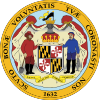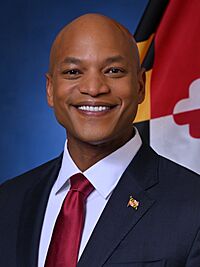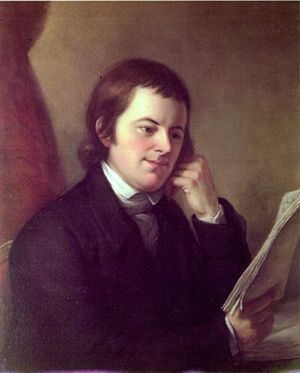Governor of Maryland facts for kids
Quick facts for kids Governor of theState of Maryland |
|
|---|---|

|
|

|
|
| Government of Maryland | |
| Style |
|
| Residence | Government House |
| Seat | Annapolis, Maryland |
| Term length | Four years, renewable once consecutively |
| Constituting instrument | Maryland Constitution of 1776 |
| Inaugural holder | Thomas Johnson |
| Formation | March 21, 1777 |
| Succession | Line of succession |
| Deputy | Lieutenant Governor of Maryland |
| Salary | $180,000 (2018) |
The Governor of the State of Maryland is like the state's top leader. They are in charge of the state government and also lead Maryland's National Guard. The governor is the most important official in Maryland. They have many powers to choose people for different jobs in the state and local governments. These powers are explained in the Maryland Constitution.
The current governor is Wes Moore. He started his job in 2023.
Contents
How is the Governor Chosen?
Like most state leaders in the United States, the governor is chosen by the people of Maryland. They serve a four-year term. The Constitution of Maryland says a governor can serve as many times as they want, but not more than twice in a row. This means a governor who has served two terms can run again later, after taking a break for at least one term.
To be a governor, a person must be at least 30 years old. They also need to have lived in Maryland and been a registered voter for five years before the election. Candidates must sign up with the Maryland State Board of Elections. They also pay a fee and share their financial information. The governor is elected in even-numbered years when there is no election for the president of the United States.
What Does the Governor Do?
The governor is the chief executive of Maryland. This means they lead the executive branch of government. This branch includes all state departments and agencies. It also includes many advisory groups and committees. The governor's main job is to run the state and make sure laws passed by the legislature are followed.
The governor also has a say in new laws. They can say "no" to (veto) any bill sent to them by the Maryland General Assembly. However, the General Assembly can still make the bill a law if enough members vote to override the veto. The governor also has powers related to state money and choosing state officials.
Managing State Money
Every year, the governor must show a proposed budget to the Maryland General Assembly. After seeing the budget, the assembly can lower parts of the budget for the executive branch. But they cannot increase it or move money between departments. They can, however, increase money for the legislative and judicial branches.
The governor can also veto specific parts of spending bills. This is called a "line item veto". If the governor vetoes something, the legislature can override it. They need three-fifths (60%) of the members in each house to vote for it.
The governor is also part of the Board of Public Works. This board has big powers in watching and approving how state money is spent. They must approve most state spending.
Choosing State Officials
The governor chooses almost all military and civilian officers for the state government. The Maryland State Senate must agree with these choices. The governor also picks people for certain boards and groups in all 24 counties and Baltimore City. For example, they appoint local Boards of Elections members.
If a job opens up in the Attorney General's or Comptroller's office, the governor fills that spot. They also fill empty seats in the General Assembly. For these, they must choose from people recommended by the local political party. The governor can remove any official they appointed if there is a good reason.
The governor's most important choices are the 24 secretaries and department heads. These people make up the governor's Cabinet, also called the executive council.
The Governor's Cabinet
The governor of Maryland leads the executive council (or Cabinet). This group helps coordinate all state government functions. Most members are chosen by the governor and approved by the Maryland State Senate.
Here are some of the members:
- Lieutenant Governor – Aruna Miller
- Secretary of State – Susan C. Lee
- Secretary of Aging – Carmel Roques
- Secretary of Agriculture – Kevin Atticks
- Secretary of Budget and Management – Helene Grady
- Secretary of Commerce – Harry Coker
- Secretary of Disabilities – Carol Beatty
- State Superintendent of Schools – Carey Wright (chosen by the State Board of Education)
- Secretary of Environment – Serena McIlwain
- Secretary of General Services – Atif Chaudhry
- Secretary of Health and Mental Hygiene – Meena Seshamani
- Secretary of Housing and Community Development – Jacob R. Day
- Secretary of Human Resources – Rafael López
- Secretary of Information Technology – Katie Savage
- Secretary of Juvenile Services – Betsy Fox Tolentino
- Secretary of Labor, Licensing, and Regulation – Portia Wu
- Secretary of Natural Resources – Josh Kurtz
- Secretary of Planning – Rebecca Flora
- Secretary of Public Safety and Correctional Services – Carolyn Scruggs
- Secretary of State Police – Roland Butler
- Secretary of Transportation – Paul Wiedefeld
- Secretary of Veterans Affairs – Ed Rothstein
- Secretary of Higher Education – Sanjay Rai
- Secretary of Service and Civic Innovation - Paul Monteiro
- Adjutant General – Janeen L. Birckhead (leads the Maryland Military Department)
Other staff members might also be invited to Cabinet meetings. The governor also oversees smaller groups called "sub-cabinets." These groups help coordinate specific state government activities that involve several departments.
Other Important Powers
The governor is the commander-in-chief of Maryland's military forces. This includes the Maryland Army National Guard and Air National Guard and the Maryland Defense Force. However, the President of the United States can call the National Guard into federal service. In emergencies, the governor can use special powers, including calling up these military forces.
In criminal justice, the governor can grant pardons to criminals. They can also reduce prison sentences or cancel fines for people who broke state laws. The governor also serves on various state and interstate boards. They must report on the state's condition at any time. This usually happens in a "State of the State" speech each January.
The Governor's Staff
The governor has a team of staff members who help with their duties. This team is led by a chief of staff. It includes offices for working with other governments, legal advice, laws and policies, and press relations. There is also a Governor's Office in Washington, D.C.. The chief of staff has deputies to help manage these departments.
History of the Governor's Office
Early Governors (1600s–1800s)
During the time Maryland was a colony, the owners (called the Lords of Baltimore) usually stayed in England. They chose someone to be the governor of Maryland for them. Leonard Calvert was the first colonial governor. He came with the first settlers in 1634.
From 1692 to 1715, Maryland was a royal colony. The British monarch appointed the governor. Then, the Lords of Baltimore got their power back in 1715. They continued choosing governors until the American Revolution (1775–1783).
After Maryland became independent, the first governor chosen by the state was Thomas Johnson. He took office on March 21, 1777.
Under Maryland's first state constitution (1776), the governor was chosen for one-year terms. Both houses of the Maryland General Assembly made the choice. In 1838, a change allowed voters to elect the governor for a three-year term. Voters from different parts of the state took turns choosing. In 1851, the term changed to four years. The requirement to be from a certain area was removed in 1864 during the American Civil War.
The current constitution was approved in 1867. In 1922, an amendment changed election years. Since then, elections have been held every four years, in the mid-term election cycle.
From 1777 to 1870, the governor lived in the Jennings House in Annapolis. Since 1870, the governor has lived in the Government House. This house is next to the Maryland State House. It is the governor's home and also has rooms for official events.
Modern Governors (1900s–Present)
Spiro Agnew was the 55th governor of Maryland from 1967 to 1969. He later became the 39th vice president of the United States under President Richard M. Nixon. Agnew left his role as vice president early. His portrait was removed from the Maryland State House Governor's Reception Room in 1979. In 1995, Governor Parris Glendening put the portrait back. He said it was important not to change history.
As of 2023, Maryland has not had a female governor. However, women have been close to winning the governor's race several times. Two women have served as lieutenant governor: Kathleen Kennedy Townsend (1995-2003) and Aruna Miller (since 2023).
Lieutenant Governor
In 1971, the job of Lieutenant Governor of Maryland was brought back. This position had only existed for a few years in the 1860s. The lieutenant governor's job is not as powerful as in some other states. They only have the powers that the governor gives them. The lieutenant governor is elected on the same ballot as the governor. They serve for the same four-year term.
The lieutenant governor becomes governor only if the governor's office becomes empty. This could happen if the governor resigns, dies, or is removed from office.
Sometimes, there have been disagreements between governors and lieutenant governors. For example, Governor Marvin Mandel and Lt. Gov. Blair Lee III had public issues. No lieutenant governor of Maryland has ever been elected governor later. Also, none have permanently taken over the governor's office because of a vacancy. However, Blair Lee III served as acting governor from 1977 to 1979. This happened while Governor Marvin Mandel was unable to serve his full term.
Timeline
| Timeline of Maryland governors |
 |
See Also
- Government of Maryland
- Lieutenant Governor of Maryland
- Maryland gubernatorial elections
- List of colonial governors of Maryland




